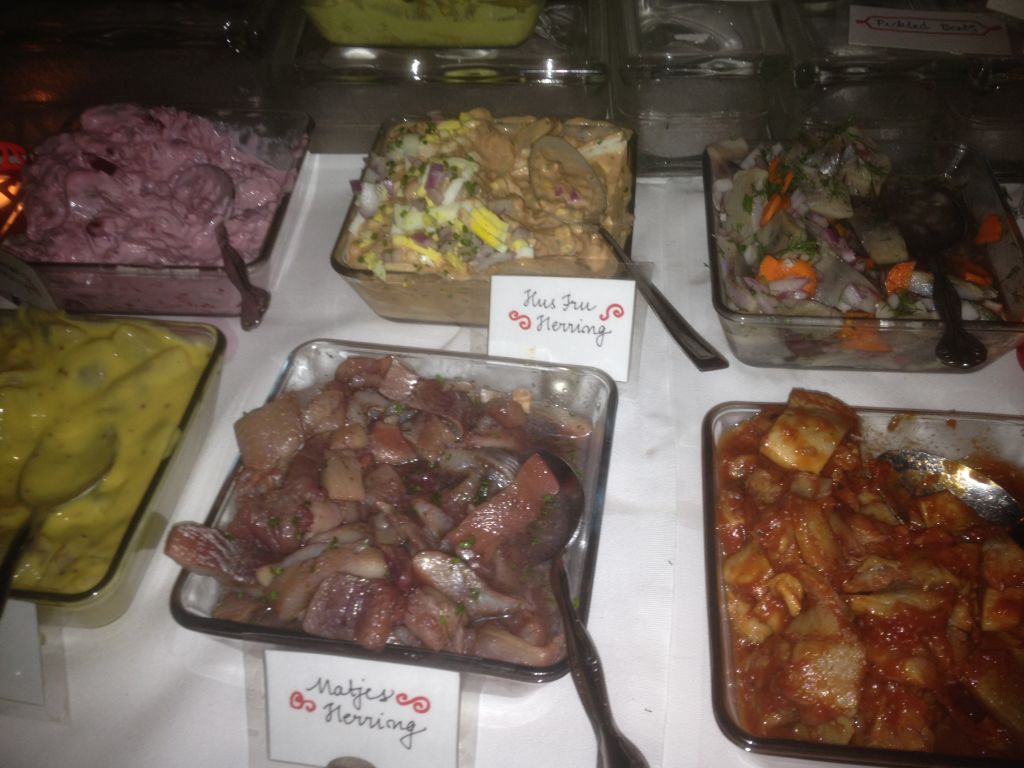
All Hail Herring! Jülbord at Tre Kronor A Delicious Tradition

There are some traditions in Chicago that need no explanation. The home openers at Wrigley and The Cell, the dyeing green of the Chicago River and the nearly annual parade of government officials being hauled off to jail. These events mark the passage of time and will endure for generations to come. But there’s another holiday tradition that’s been etched on my culinary calendar the past few years, and its star is herring.

Every December, Tre Kronor hosts its jülbord (Christmas table) feast for a limited time – just two seatings per night, and only on certain days – and the stunning array of Swedish food is both mind-boggling as well as delicious, as I so happily re-discovered on Saturday night. Before you even settle in, owners Larry Anderson and Patty Rasmussen have guests mingle in the backyard, sipping glögg (spiced, mulled wine) or anything they may have brought, since it’s BYOB.

Your table is first welcomed into a small alcove, just off the main dining room (they also open the upstairs dining room, which has its own small food alcove). Servers explain how the meal should progress, generally starting with the cold items – including a diverse selection of pickled herring, or sil, as it’s called in Sweden, in about 10 different flavors. Mustard, curry, dill, garlic herb, tomato, matjes and Christmas (with beets) are set out in glass bowls, next to crisp stacks of knäckebröd, the ubiquitous crackers Swedes use to nosh on with their sil.

I always smile a little when I eat herring, as it reminds me of my dad, who always had a jar of it in our fridge, and would tell me stories of how his father, a Russian immigrant who rolled his own cigarettes and escaped the pogroms of the early 1900s, would keep an entire herring in the ice box, and just hack off a piece whenever the mood struck.

As you move your way down the line, there is an ocean of more seafood: oysters, chilled shrimp, salmon (gravlax) three ways – hot smoked, cold smoked and new this year, cured in beet juice, which gives the outer layer a beautiful, rosy red hue; a mildly spicy mustard sauce is always offered alongside. Meanwhile, servers move around the dining room, occasionally offering a gratis sip of dill or lingonberry-flavored aquavit, Sweden’s national spirit.


There’s a salad with fresh citrus and hazelnuts, an assortment of cured meats such as reindeer, and an entire poached salmon to pick from as you choose. Another section of the cold table is overloaded with pickled, purplish-red beets and Swedish Deviled Äggs; soft liver patés and mousses and pickled cucumbers; Jarlsberg and Västerbotten cheeses, as well as gjetost (goat cheese) and Danish blue cheese.
On the hot side of the jülbord, there’s enough protein to choke even Guy Fieri: Christmas ham, Swedish meatballs with lingonberries, dilled lamb and prinskorv (small sausages); potato sausages and brown beans, plus, a potato dish I can still taste in my dreams: Jansson’s Temptation – essentially shredded potatoes that have been baked with heavy cream and Swedish anchovies. It’s creamy and earthy and yet also has a great depth from the anchovy. Vegetables include creamed spinach and braised red cabbage, and there’s always that Nordic treasure, a punchline from some epidsode of “The Prairie Home Companion” and my childhood in Minnesota: lutefisk (dried cod treated with lye) thanks, but I’ll pass on that one.


Just before dessert is set out, a few members of the staff always explain the history of the Festival of Santa Lucia. According to Scandinavian tradition, it was in Värmland, Sweden, where a white-clad maiden, wearing a crown of burning candles, brought food to the starving villagers on the shores of Lake Vänern. In the pre-dawn hours of December 13th, (the longest night of the year), the eldest daughter in each Swedish household comes to her sleeping parent’s room, dressed in a long white gown tied with a red sash, wearing a crown of lingonberry leaves in which are set seven lighted candles. The procession includes sisters and brothers also dressed in white, holding candles, singing of the light and joy of Christmas. Awakened by the lights and the singing, the parents get up and eat breakfast, ushering in the Christmas season. At Tre Kronor, the young servers dress in white, one of whom wears the glowing crown, and they sing a few Christmas songs. Set against the glow of the room, it is truly magical, no matter which holiday you celebrate.


Then it’s on to the dessert table, with large oval bowls filled with rice pudding, burnt custard and saffron poached pears. Cardamom crème cakes and Swedish cookies fill what little space remains on the small table, along with Norwegian julkaga (Christmas bread) and chocolates. After a feast like this, one has few options but to simply give in, and drift off to sleep…


Tre Kronor’s jülbord runs every night except Sunday, now thru Dec 23. There are two seatings: 5/5:30 p.m. and 8 p.m.. Cost is $55 per person, $60 on Friday and Saturday.
